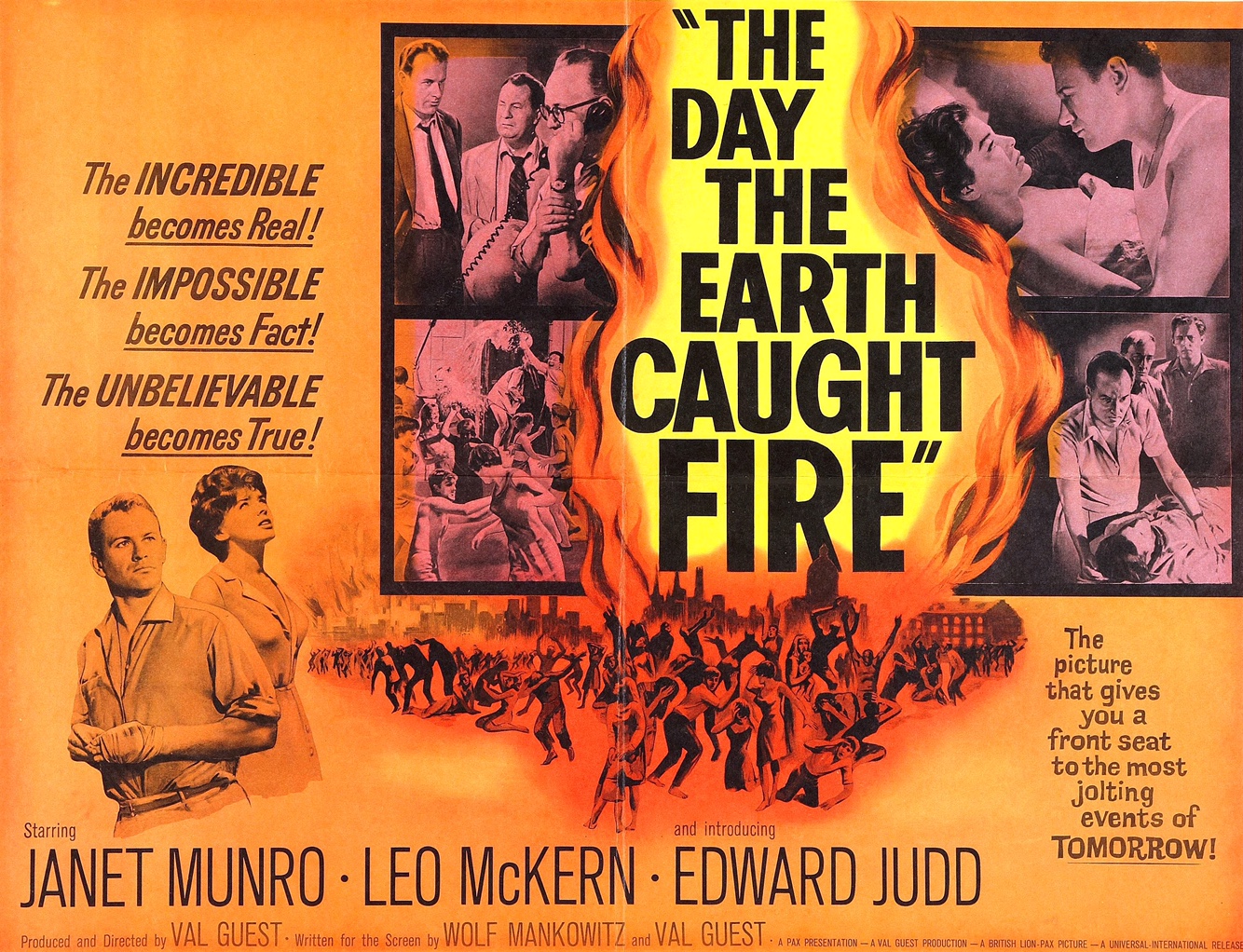
The Day the Earth Caught Fire is a British science fiction disaster film starring Edward Judd, Leo McKern and Janet Munro. It was directed by Val Guest and released in 1961, and is one of the classic apocalyptic films of its era. The film opened at the Odeon Marble Arch in London on 23 November 1961.
The film, which was partly made on location in London and Brighton, used matte painting to create images of abandoned cities and desolate landscapes. The production also featured the real Daily Express, even using the paper’s own headquarters, the Daily Express Building in Fleet Street, London. A lone man walks through the sweltering streets of a deserted London. The film then goes back several months. Peter Stenning (Judd) was an up-and-coming journalist with the Daily Express but a messy divorce has thrown his life into disarray. His Editor (Christiansen) has begun giving him lousy assignments. He begins drinking too much. (One of his lines is, “Alcoholics of the press, unite!” Stenning’s only friend, Bill Maguire (McKern), is a veteran Fleet Street reporter who offers him encouragement and occasionally covers for him by writing his copy.
Meanwhile, after the Soviet Union and US detonate simultaneous nuclear bomb tests, strange meteorological events begin to affect the globe. Stenning is sent to the British Met Office to obtain mean temperature data. While there he meets Jeanie (Munro), a young telephonist. They “meet cute”, trading insults; later, they fall in love.
In the film’s orange-infused opening sequence, Edward Judd walks through a devastated and deserted London.
Stenning then discovers that the weapons tests had a massive effect on the Earth. He asks Jeannie to help him get any relevant information. At first it becomes clear that the Earth obliquity has been altered by 11 degrees, altering the climatic zones and changing the pole and the equator. The increasing heat has caused water to evaporate and mists to cover Britain. Eventually it is shown how the whole orbit of the Earth has been pushed inwards towards the sun.
The government imposes a state of emergency, and starts rationing supplies. People start evacuating the cities. Scientists conclude that the only way to bring the Earth back into a safer orbit is to detonate a series of nuclear bombs in western Siberia. Stenning, Maguire and Jeanie gather at a bar to await the outcome. As the countdown reaches zero the bombs are detonated; 30 seconds later the shock wave travels round the world, causing dust to fall from the bar’s ceiling. Two versions of the newspaper’s front page have been prepared: one reads “World Saved”, the other “World Doomed”. Stenning, because he broke the story, dictates the day’s editorial, still without any indication of whether the nuclear blasts have been successful or not. In the meantime, a few remaining printers wait by the presses for the word of which headline will be used.
The film concludes ambiguously with the sound of pealing church bells. The audience is left to decide whether this heralds a new beginning for mankind or its doom.
Production:
Val Guest says there was a lack of enthusiasm to make the film and he only managed to persuade British Lion to finance it by putting up his profits from Expresso Bongo as collateral. All the finance was British. The film was made in black and white but in some original prints, the opening and closing sequences are tinted orange-yellow to suggest the heat of the sun. It was shot with 35 mm anamorphic lenses using the French Dyaliscope process. Critic Doug Cummings said, about the look of the film, “Guest also manages some visual flair. The film was shot in anamorphic widescreen, and the extended frame is always perfectly balanced with groups of people, city vistas, or detailed settings, whether bustling newsrooms, congested streets, or humid apartments. Although the film’s special effects aren’t particularly noteworthy, matte paintings and the incorporation of real London locations work to good atmospheric advantage (heavy rains buffet the windows; thick, unexpected fog wafts through the city; a raging hurricane crashes into the British coast). Guest also cleverly incorporates stock footage to depict floods and meteorological disasters worldwide. The visual style of the film is straightforward and classical, but each scene is rendered with a great degree of realism and sense of place.”
Reviewer Paul A. Green wrote, “Guest and his editor Bill Lenny worked with archive footage. There’s a quick shot of a fire-engine from The Quatermass Experiment – but otherwise you can’t see the joins.”
In his commentary track for the 2001 Anchor Bay DVD release, director Val Guest stated that the sound of church bells heard at the very end of the American version had been added by distributor Universal, in order to suggest that the emergency detonation had succeeded and that the Earth had been saved. Guest speculated that the bells motif had been inspired by the 1953 film The War of the Worlds, which ends with the joyous ringing of church bells after the emergency (and a nuclear explosion). But Guest maintained that his intention was to always have an ambiguous ending.
Monty Norman, who was credited with writing “Beatnik Music” in a couple of scenes, would become well known one year later when his “James Bond theme” was used in the title sequence of Dr. No.